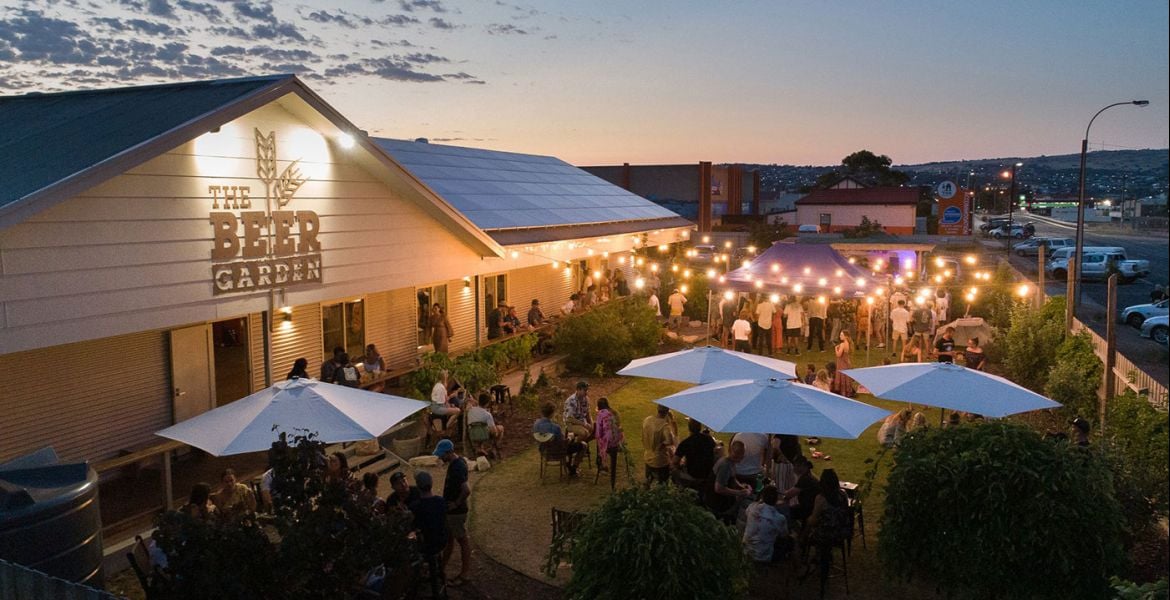There was a period not too long ago when beers from NZ brewers were ever-present on the taps of Aussie beer bars and commanded swathes of fridge space in the country's craftier bottleshops. Today, their presence is much reduced, as the flow of imported beers from all parts of the world has slowed. Yet you could argue the Kiwi influence on the local beer scene has never been greater – and that's down to the growing ubiquity of the country's hops.
Australian brewers have been using New Zealand hop varieties in their beers for far longer than we've been writing about them – back in Murray's Brewing's heyday, then head brewer Shawn Sherlock used nothing else in his beers, for example – yet with more choosing to brew with older varieties such as Nelson Sauvin, Riwaka and Motueka, and newer arrivals such as Nectaron, Peacherine and Superdelic appearing wherever you look, they've never been more in fashion.
If once they popped up now and then like Dave Dobbyn’s Slice Of Heaven on FM radio, now they’re hitting high rotation with new releases dropping faster than you can mis-pronounce Motueka (“mow·too·eh·kuh”, or just “Mot” for short).
So what gives? Why have New Zealand’s hops grabbed the attention of Aussie brewers and drinkers? What’s changed in recent years to fuel this trans-Tasman takeover? Let’s dive in.
Enter A New (Zealand) Challenger

The prevalence of beers featuring, and often named after NZ hops – Superdelic or Nectaron IPAs, for example, or those referencing the experimental varieties in the Bract Brewing Programme (NZH-106 and 109 are currently doing the rounds) – might make it feel like they've tapped your tinnies overnight, yet the groundwork has been years in the making.
For a period, their presence was held back by higher prices, limited availability and distribution, and under-promotion but, while high-impact hops like Galaxy from HPA and Citra from the USA were grabbing the headlines, the New Zealand industry was ramping up and starting to kick goals. The combination of innovative hop farms – the likes of Clayton Hops, Freestyle Hops and Eggers – plus major investment, stronger distribution deals and competition saw prices drop and NZ hops become a real contender.
“The profile of NZ hops in Australia – and, more broadly, globally – has definitely exploded over the last three years,” says Sam Bethune, technical sales specialist at Bintani, who took over Australian distribution of the New Zealand Hops Ltd cooperative in 2021 after acquiring Hopco. “We can’t share specific numbers but they have outperformed versus our market benchmarks.
“Previously, it was often hard to get your hands on in-demand hops like Nelson Sauvin and Riwaka – especially without a forward contract – and pricing could be cost prohibitive at times compared to Australian and US varieties. The scene has changed remarkably now though.”

In addition to higher output and lower prices, farmers – working with New Zealand’s famed hop-breeding Plant & Food Research Institute – have not only released the steady stream of exciting new varieties referenced above but also a series of advanced hop products. These cutting-edge cryo hop pellets and distilled hop oils have further fuelled brewers’ thirst and imagination in the never-ending race for bigger and more diverse flavours – discover more in our guide to new hop products currently available in Australia.
Since launching in 2017, Clayton Hops – run by brothers Brian, Andrew and Glen – has quickly become New Zealand’s largest hop grower with four farms spread over 1,350 acres in the Tasman region. Two years ago, they built the country's largest hop processing plant too: it can produce three tonnes of hop pellets an hour, as well as their Amplifire range of cryo hops and oils.
“In the past, Aussie brewers often just used Kiwi hops in seasonal releases because they couldn’t get reliable supply to do core range beers,” CEO Brian explains.
“We want to be in those core ranges, and if you want to compete with the likes of Citra and Galaxy you need to give brewers comfort of supply at a good price point. Now New Zealand has the scale, reliability and great processing to do that.”
Leading The Charge

“As a brewer and a consumer, I think NZ hop producers are leading the charge, and everyone's sort of trying to play catch up, to be honest,” says Damien “Damo” Martin, founder of Dangerous Ales on the NSW South Coast.
He should know too: he’s won the trophy for Champion Hazy IPA at the Indies two years in a row for beers brewed with NZ hops. In August, his Mt Cooked Hazy New Zealand IPA – loaded with Nelson Sauvin and Nectaron – claimed top honours while the Riwaka-fuelled Fightin' With Lightnin' triumphed in 2023. On top of that, Dangerous Ales’ Crispy Boi core range lager – which makes up 40 percent of production as well as appearing in longnecks as Tall Boi – uses nothing but Nelson Sauvin.
“We’re really excited about these new flavours and aromas that haven’t been on the market long,” he says. “I guess Nelson has, but once you blend them with newer varieties like Nectaron and Peacherine, there’s a lot of flavour and aroma people haven't been able to achieve yet.
“It’s also more exciting than making a beer with Mosaic and Citra, which everyone's had like a hundred times already.”
He’s also discovered other benefits within the brewing process.
“We’ve found we can push dry-hopping a lot harder without getting the hop burn we’d get from pellets from other parts of the world,” he adds, “so our beers are ready to package sooner.”
Damo isn’t the only brewer frothing over the possibilities NZ hops have to offer. Nick Calder-Scholes, head brewer at One Drop in Sydney, is a huge fan and it’s not just because he’s a Kiwi himself.
“Customers aren’t wanting big, piney, citrus IPAs with a lot of bitterness anymore,” he says. “They want soft, nuanced products with more complex hop character and distinctive fruit notes, especially for hazy beers, and NZ hops excel at that.
“At the moment, they’re just far more expressive in aroma and flavour and really lend themselves to what the modern IPA is.”

For Mark Howes, co-founder and head brewer at Working Title in Brisbane, versatility is also a huge drawcard.
“New Zealand hops have such a broad spectrum of flavours, so you can use them in a pilsner or an IPA or XPA, even black beers. One of the big reasons why they’re becoming so popular is because you can just do so many things with them.”
With a doctorate in microbiology, Mark is equally as excited about the rapid release of new hop types and products on the market, along with the cutting-edge research accompanying them. Like Nick, he’s an invite-only member of Freestyle Hops’ Research Collective, which is just one of New Zealand’s pioneering programs alongside the likes of NZ Hops Ltd’s Bract Brewing Programme and the Hāpi Brewing Success programme.
Via Freestyle Hops, Mark has already been able to brew with unreleased varieties such as Paradisi and Manalita, as well as road-testing hybrid products like Mega Motueka and Super Sauvin, which include Phantasm thiol powder for greater flavour – more on Phantasm here.
“They’re making some really crazy, expressive stuff, which is incredibly exciting to work with,” Mark says. “We get early access to products before they hit the market because they want feedback during development.”
Nick adds: “They'll fly over here and do a collab with you. They'll give you first access to a new product or their knowledge base, like hop combinations or different dry-hopping techniques. Rather than just getting the five or six main oils tested in a hop, they'll go and test a fucking shit-tonne and get thiols tested in France, which costs a stupid amount of money.
“So, not only do you have more sensory input, you have more data than any other supplier will give you. Freestyle will even give you day-to-day updates from the farm during harvest if you want them. [NZ suppliers] just seem very open to experimentation and collaboration, whereas other suppliers are just like, ‘We're a storefront and you buy off us’ and that's where the relationship ends.”
Choice Az Choice

“Newer breweries or smaller breweries are able to access Kiwi hops really easily,” Nick says of the choice and flexibility on offer. “As Australian and US suppliers have grown bigger and bigger, they've been putting larger and larger caps on minimum orders [if you want to specifically select the farm lot you're after].
“So, unlike the amazing Citra [from the US] where you need to order 2.5 tonnes to select, with NZ hops some suppliers will let you select for only 40 kilograms. That allows brewers to have so much more control over their base ingredient.”
Fellow Sydney-based brewer Brady Hannett, from Future Brewing, is another recent Kiwi convert. Since opening his brewery in the Inner West last year, he’s already earned a fierce reputation on the back of hop-driven beers featuring mostly Kiwi varieties.
“I think smaller hop growers can relate to small breweries – it’s a quality-focused environment,” he says. “Their customer service is awesome and they’re interested in more than just making sales. They’re hungry to improve and learn and get feedback. The quality is better and being able to know what you're going to get from a hop before you put it in a beer is reassuring.”
Damo agrees wholeheartedly: “The price is no different to buying Citra or anything like that, but the level of support NZ hops give you is great.
“Like, if you say, ‘We got some flavours in this batch that we're not looking for’, a lot of other guys are like ‘Well, everyone else is happy with them so they’re fine.’ But these guys will say, ‘No, that's super important to us’ – they’ll trace the cause back and then help you out with some free boxes too.
“I just think that's the way we run our business, and I appreciate it when other people are the same.”






















